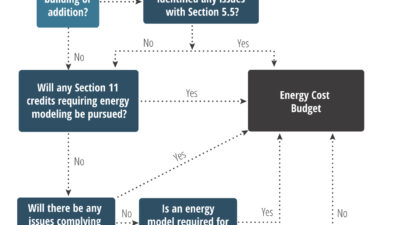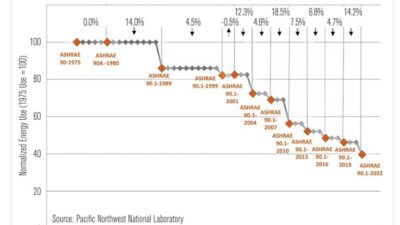Building managers and owners are becoming increasingly aware that controlling building temperature alone is not sufficient to meet occupants’ comfort and health needs. Proper ventilation can contribute to increased productivity, improved employee satisfaction, lower absenteeism and reduced health costs. It can also reduce tenant turnover and contribute to maximizing profits in leased space.
Even so, building managers wrestle every day with the challenge of maintaining a safe and comfortable environment while keeping operating costs in check. HVAC experts have long known that economizers and demand control ventilation (DCV) can result in energy savings and improved air quality for commercial buildings, but without comprehensive evaluations of these strategies, building managers have been unable to identify measurable benefits.
That’s why Honeywell recently funded a series of independent, comprehensive studies to measure energy use associated with leading ventilation control strategies for commercial buildings. In the studies, researchers from Purdue University and other institutions evaluated typical energy requirements associated with alternative ventilation control strategies for constant-air-volume (CAV) systems, e.g., packaged rooftop systems, in commercial buildings.
These studies point toward a ventilation solution that lowers energy costs and insures facility comfort: solid-state differential enthalpy economizer controls integrated with reliable, CO 2 sensor-based demand control ventilation. These studies clearly demonstrate that this type of integrated solution provides an easily implemented, cost-effective way to cut energy costs while delivering proper ventilation to building occupants.
Ventilation Basics
ANSI/ASHRAE Standard 62-1999 provides guidance to maintain adequate indoor air quality in buildings. While there are a number of approaches to implementation of the standard, the most common approach is to dilute indoor pollutants through ventilation, defined as the intentional introduction of air from outside the building.
The standard recommends the minimum ventilation airflows necessary to maintain satisfactory indoor air quality. The minimum requirement depends upon the type of building and the occupancy. Typically, for CAV systems, the ventilation flow rate is determined based upon design occupancy for the specific building type and outdoor dampers are set to maintain a constant ventilation airflow.
This approach conforms to the Ventilation Rate Procedure of the standard. However, with this strategy, the ventilation rate exceeds the minimum when the building is not fully occupied. The energy requirements to heat and cool a building can often be reduced if the ventilation airflow is adjusted in response to the number of occupants.
Building Managers can implement an adjustable ventilation airflow by controlling the ventilation to maintain a specific CO 2 level within the building. This strategy is referred to as demand-controlled ventilation. The energy savings associated with demand-controlled ventilation (as compared with minimum ventilation based upon design occupancy) depend upon several factors, including the building characteristics, occupancy schedule and climate. In addition, the savings depend upon the type of economizer system employed.
Ventilation Strategies
One of the Purdue University studies, conducted in 1998, found that using a differential enthalpy economizer control with demand control ventilation can save up to 80 percent in energy bills annually in some applications.
The research further found that using a fixed minimum outside airflow strategy is the most expensive option in all applications; and that demand control ventilation alone doesn’t always save energy. In fact, it actually drives up energy costs in some locations.
In this study, researchers simulated conditions using three sets of variables. First, their simulations encompassed four different buildings: an office building, large retail store, school and sit-down restaurant. The researchers developed their models based on building descriptions and characteristics from commercial building prototypes.
Second, the study simulated energy use for those buildings in 20 cities, including Boston, Miami, Madison, Wis., Atlanta and Albuquerque. N.M.; Denver; and Seattle.
And third, the researchers evaluated energy consumption using eight different control strategies: basic ventilation control; basic control plus economizer options with three different inputs (outdoor dry bulb, single outdoor enthalpy and differential enthalpy); and demand-control ventilation.
Across all 640 simulated situations, researchers found that:
%%POINT%%Using a base ventilation control strategy is the most expensive option in every situation.
%%POINT%%Actual building occupancy generally falls far short of the maximum expected (i.e., design) occupancy.
%%POINT%%Economizers helped reduce energy costs in every application.
%%POINT%%In most cases, a differential enthalpy economizer integrated with a demand control ventilation saved the most in energy costs. Potential energy savings in the study ranged from 30 percent to more than 80 percent depending on climate and building type. This may not be the case for every area of the country and building type.
%%POINT%%Demand control ventilation resulted in significant energy savings in the heating mode.
Savings estimator tools have been developed based on this research to assist the building manager is determining if one of the strategies will save energy in their area.
In a 2003 study commissioned by the California Energy Commission and sponsored by Honeywell, researches simulated cost savings and yearly payback results for three different strategies that reduce ventilation loads in small commercial buildings: demand-controlled ventilation, heat pump heat recovery and enthalpy exchangers. The simulations were performed for 16 California climate zones using calibrated ventilation strategy assessment tool (VSAT).
Operating cost savings for each of the different ventilation technologies researched in this study can result from reduced ventilation loads. DCV reduces the ventilation load by reducing the ventilation flow-rate in response to CO 2 levels in the zone. The heat pump and enthalpy exchanger reduce the ventilation load by recovering heat between the exhaust and ventilation flow streams.
In this study, DCV coupled with an economizer (DCV+EC) was found to give the largest cost savings relative to an economizer-only system for a number of different prototypical buildings and systems evaluated in the climate zones.
According to this study, DCV reduces ventilation requirements and loads whenever the economizer is not enabled and the occupancy is less than the peak design value typically used to establish fixed ventilation rates according to ASHRAE Standard 62-1999. Lower ventilation loads lead to lower equipment loads, energy usage and peak electrical demand.
The greatest cost savings occur for buildings that have low average occupancy relative to their peak occupancy, such as auditoriums, gyms retail stores. The total cost savings for DCV+EC ranged from about 1 percent to 48 percent, and the electrical demand savings were between 1 percent and 52 percent. Payback associated with DCV+EC ranged from 0.3 to 6 years for most locations throughout California. From a climate perspective, hotter climates result in higher relative saving for cooling and colder climates give higher relative savings for heating.
Conclusion
These studies provide hard data that technologies are readily available to maintain comfortable indoor environments while significantly cutting energy bills. Obviously, every building is different, and actual savings will depend on such critical factors as building construction, usage, actual occupancy, location and nature of its HVAC equipment, parameter settings and control systems. But, based on these studies, there is no question that using a fixed minimum-air ventilation strategy based on design occupancy is needlessly expensive.
About the Authors: Adrienne Thomle is a Senior Product Manager for Honeywell Environmental Control and Combustion and can be reached at [email protected] . Eric Peterschmidt is a Marketing Manager for Honeywell Building Solutions and can be reached at [email protected] . To learn more about evaluating ventilation strategies for your facility, visit www.honeywell.com .



